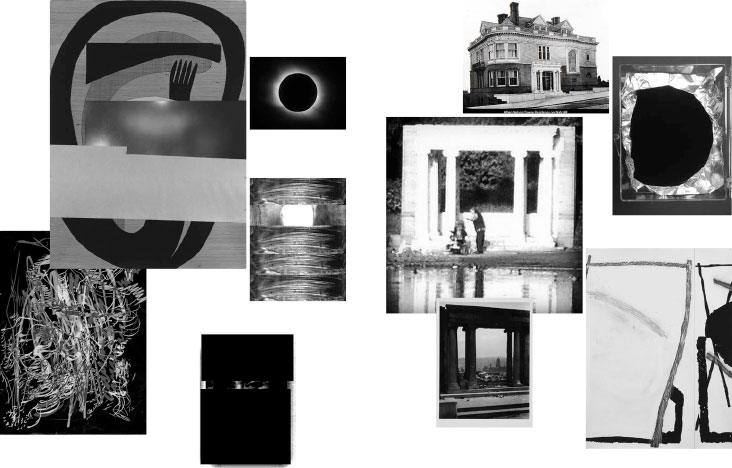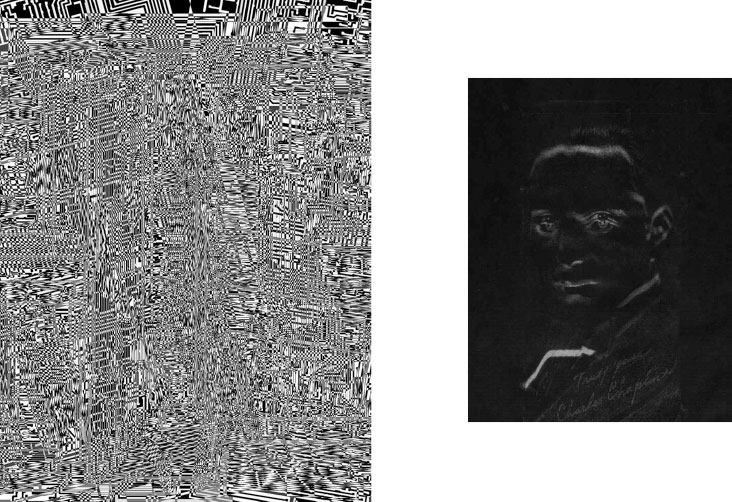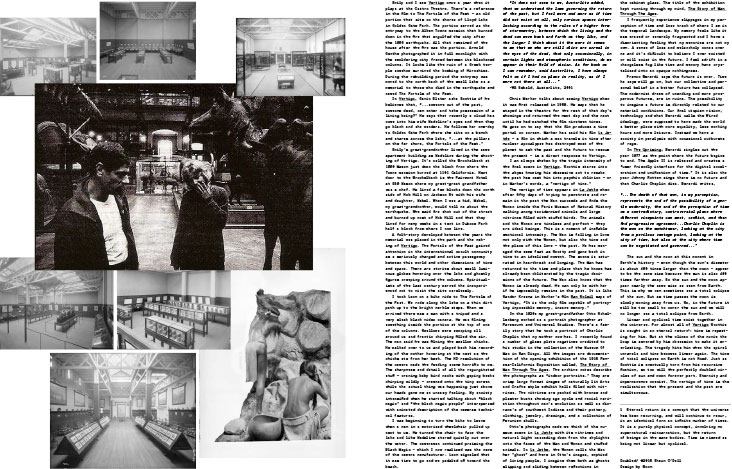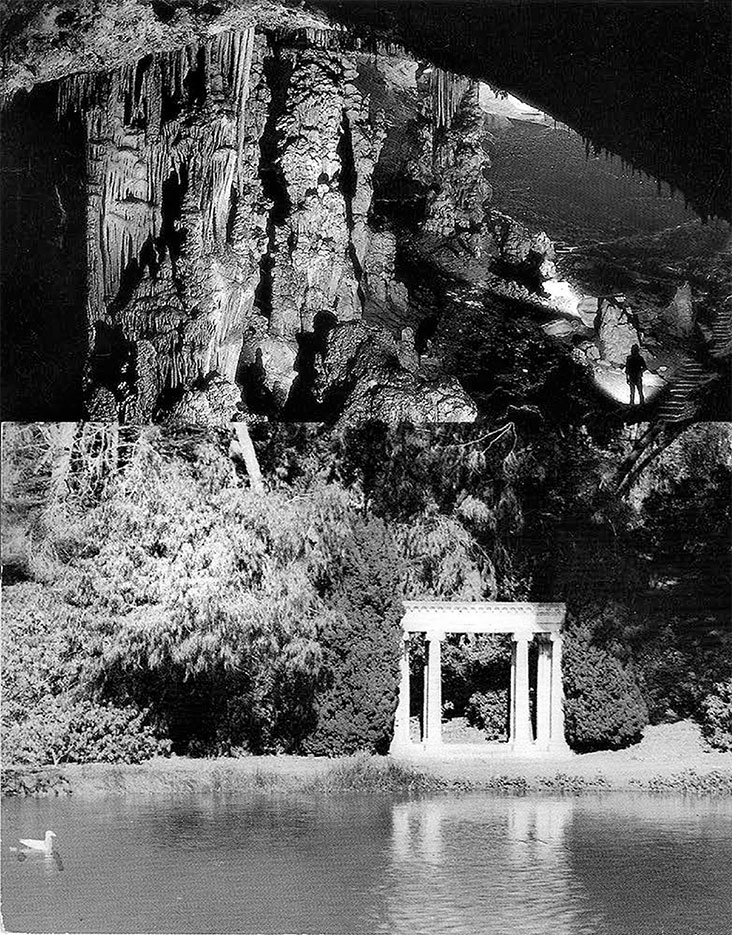




Emily and I see Vertigo once a year when it plays at the Castro Theatre. There’s a reference in the film to The Portals of the Past - an old portico that sits on the shores of Lloyd Lake in Golden Gate Park. The portico served as the entryway to the Alban Towne mansion that burned down in the fire that engulfed the city after the 1906 earthquake. All that remained of the house after the fire was the portico. Arnold Genthe photographed it in full moonlight with the smoldering city framed between its blackened columns. It looks like the ruin of a Greek temple somehow survived the bombing of Hiroshima. During the rebuilding period the entryway was moved to the north bank of the small lake as a memorial to those who died in the earthquake and named The Portals of the Past.
In Vertigo, Gavin Elster asks Scottie if he believes that, ”...someone out of the past, someone dead, can enter and take possession of a living being?” He says that recently a cloud has come into his wife Madeline’s eyes and then they go blank and she wanders. He follows her one-day to Golden Gate Park where she sits on a bench and stares across the lake, “...at the pillars on the far shore, the Portals of the Past.”
Emily’s great-grandmother lived in the same apartment building as Madeline during the shooting of Vertigo. It’s called the Brockelbank at 1000 Mason just down the block from where the Towne mansion burned at 1101 California. Next door to the Brockelbank is the Fairmont Hotel at 950 Mason where my great-great grandfather was a chef. He lived a few blocks down the north side of Nob Hill on Jackson St with his wife and daughter, Mabel. When I was a kid, Mabel, my great-grandmother, would tell me about the earthquake. She said fire shot out of the street and burned up most of Nob Hill and that they lived for many weeks in a tent in Duboce Park half a block from where I now live.
A folk-story developed between the years the memorial was placed in the park and the making of Vertigo. The Portals of the Past gained attention in the international occult community as a seriously charged and active passageway between this world and other dimensions of time and space. There are stories about small luminous globes hovering over the lake and ghostly figures creeping around the columns. Spiritualists of the last century warned the inexperienced not to visit the site carelessly.
I took Leon on a bike ride to The Portals of the Past. We rode along the lake on a thin dirt path up to the bright marble steps. When we arrived there was a man with a tripod and a very sleek black video camera. He was filming something inside the portico at the top of one of the columns. Swallows were swooping all around us and frantic chirping filled the air. The man said he was filming the swallow chicks. He walked over to us and played back his recording of the mother hovering at the nest as the chicks ate from her beak. The HD resolution of the camera made the feeding scene horrific to me. The sharpness and detail of all the regurgitated stuff — craning baby bird necks with gaping beaks chirping wildly — crammed onto the tiny screen while the actual thing was happening just above our heads gave me an uneasy feeling. My anxiety intensified when he started talking about “black magic” and “the black magic people” interspersed with animated description of the cameras technical features.
I was beginning to turn the bike to leave when a man in a motorized wheelchair pulled up next to us. He turned the chair to face the lake and like Madeline stared quietly out over the water. The cameraman continued praising the Black Magic - which I now realized was the name of the camera manufacturer. Leon signaled that it was time to go and we pedaled off toward the beach.
“It does not seem to me, Austerlitz added, that we understand the laws governing the return of the past, but I feel more and more as if time did not exist at all, only various spaces interlocking according to the rules of a higher form of stereometry, between which the living and the dead can move back and forth as they like, and the longer I think about it the more it seems to me that we who are still alive are unreal in the eyes of the dead, that only occasionally, in certain lights and atmospheric conditions, do we appear in their field of vision. As far back as I can remember, said Austerlitz, I have always felt as if I had no place in reality, as if I were not there at all...”
-WG Sebald, Austerlitz, 2001
Chris Marker talks about seeing Vertigo when it was first released in 1958. He says that he stayed in the theatre for the rest of that day’s showings and returned the next day and the next until he had watched the film nineteen times. He goes on to say that the film produces a time portal on screen. Marker has said his film La Jetée – a film in which a man travels in time after nuclear apocalypse has destroyed most of the planet to ask the past and the future to rescue the present – is a direct response to Vertigo.
I am always shaken by the tragic intensity of the final scene in Vertigo. Scottie stares into the abyss knowing his obsessive act to remake the past has cast him into psychic oblivion - or in Marker’s words, a ”vertigo of time.”
The vertigo of time appears in La Jetée when after fifty days of trying to penetrate and remain in the past the Man succeeds and finds the Woman inside the Paris Museum of Natural History walking among taxidermied animals and large vitrines filled with stuffed birds. The animals and the Woman are timeless and perfect - they are ideal beings. This is a moment of ineffable emotional intensity. The Man is falling in love not only with the Woman, but also the time and the place of this love – the past. He has managed the same feat as Scotty and gone back in time to an idealized moment. The scene is saturated in heartbreak and longing. The Man has returned to the time and place that he knows has already been obliterated by the tragic decisions of the future. The Man also knows that the Woman is already dead. He can only be with her if he impossibly remains in the past. It is like Sandor Krasna in Marker’s film San Soleil says of Vertigo, “It is the only film capable of portraying impossible memory, insane memory.”
In the 1920s my great-grandfather Otto Schellenberg worked as a portrait photographer at Paramount and Universal Studios. There’s a family story that he took a portrait of Charlie Chaplin that my mother now has. I recently found a number of glass plate negatives credited to his studio in the collection of the Museum Of Man in San Diego. All the images are documentation of the opening exhibition of the 1915 Panama-California Exposition called, The Story of Man Through The Ages. The archive notes describe the photographs as “indoor portraits.” They are crisp large format images of naturally lit Arts and Crafts style exhibit halls filled with vitrines. The vitrines are packed with bronze and plaster busts showing age cycle and racial variation throughout man’s evolution as well as diorama’s of southwest Indians and their pottery, clothing, jewelry, drawings, and a collection of Peruvian skulls.
Otto’s photographs made me think of the museum scene in La Jetée with its vitrines and natural light cascading down from the skylights onto the faces of the Man and Woman and stuffed animals. In La Jetée, the Woman calls the Man her ”ghost” and here in Otto’s images, emptied of living people, I imagine them both as ghosts slipping and sliding between reflections in the cabinet glass. The title of the exhibition kept running through my mind, The Story of Man Through The Ages.
I frequently experience slippages in my perception of time and lose track of where I am in the temporal landscape. My memory feels like it was erased or severely fragmented and I have a disorienting feeling that my memories are not my own. A sense of loss and melancholy comes over me and it’s difficult to believe I ever existed or will exist in the future. I feel adrift in a changeless fog like time and memory have crystalized into an opaque nothingness.
Franco Berardi says the future is over. Time he says will go on, but our collective and personal belief in a better future has collapsed. The modernist dream of unending and more prosperous futures, are in ruins. The possibility to imagine a future is directly related to our material conditions. Our final utopian vision, technology and what Berardi calls the Wired ideology, were supposed to have made the world a better place with more equality, less working hours and more leisure. Instead we have a society in paralysis with occasional outbursts of rage.
In The Uprising, Berardi singles out the year 1977 as the point where the future begins to end. The Apple II is released and creates a “user friendly interface for the digital acceleration and unification of time.” It is also the year Johnny Rotten sings there is no future and that Charlie Chaplin dies. Berardi writes,
“...The death of that man, in my perception, represents the end of the possibility of a gentle modernity, the end of the perception of time as a contradictory, controversial place where different viewpoints can meet, conflict, and then find progressive agreement...Charlie Chaplin is the man on the watchtower, looking at the city from a perilous vantage point, looking at the city of time, but also at the city where time can be negotiated and governed...”
The sun and the moon at this moment in Earth’s history – even though the sun’s diameter is about 400 times larger than the moon – appear to be the same size because the sun is also 400 times farther away. So the sun and the moon appear nearly the same size as seen from Earth. This is why we can sometimes see a total eclipse of the sun. But as time passes the moon is slowly moving away from us. So, in the future it will be too small to cover the sun and we will no longer see a total eclipse from Earth.
Linear and cyclical time exist together in the universe. For almost all of Vertigo Scottie is caught in an eternal return: time is repeating for him. But at the climax of the movie the loop is severed by his obsession to make it everlasting. The tragedy hits him when the spiral unravels and time becomes linear again. The time of total eclipses on Earth is not fixed. Just as Scottie is eventually torn from his recursive fixation, so too will the perfectly doubled circles of sun and moon forever part. Eternity and impermanence coexist. The vertigo of time is the realization that the present and the past are simultaneous.
Eternal return is a concept that the universe has been recurring, and will continue to recur, in an identical form an infinite number of times. It is a purely physical concept, involving no supernatural reincarnation, but the return of beings in the same bodies. Time is viewed as being not linear but cyclical.